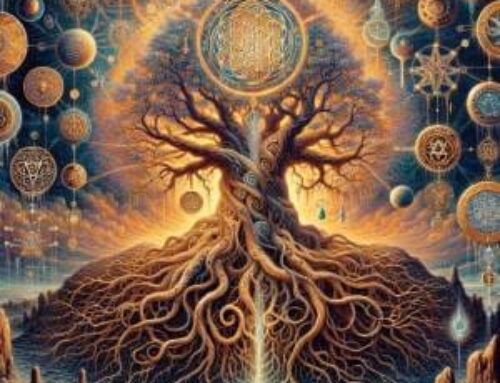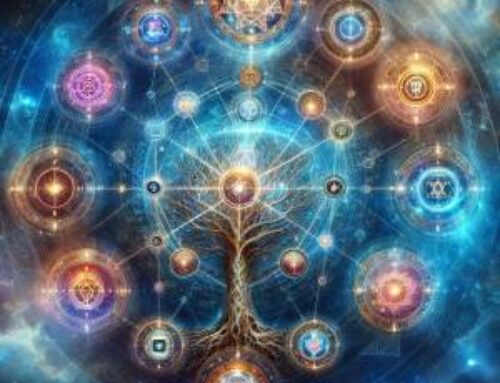Contents
What is Mysticism: Hermetic Wisdom Explored
Ever wondered about the intricate dance between the mystical and the mundane? It’s not a new curiosity—people have been diving into these deep waters for centuries, seeking truths that go beyond the ordinary. Mysticism, elusive and profound, defies easy definitions. It’s a personal journey into the heart of the divine, stretching across various traditions and practices. At its core, it’s about direct, experiential knowledge that transcends dogma. But let’s not get ahead of ourselves; let’s explore this through the unique lens of Hermetic wisdom (1). Now let’s find out “What is Mysticism” and how it can lead to a deeper connection with the divine.

An Elusive Quest: Direct Experience
Now, “What is Mysticism”? At its heart, mysticism is about direct, personal experiences with the divine. Imagine your consciousness merging with a higher state of being—a sense of oneness, peace, and insight that words can scarcely capture. In the Hermetic tradition, this is the ultimate spiritual goal, a profound union with the divine.
Hermetic Techniques: To achieve this mystical state, Hermeticism offers various practices—meditation, visualization, rituals. These are not just esoteric exercises but disciplined paths leading to gnosis, or direct knowledge. Through focused contemplation on symbols and texts, practitioners unlock deeper layers of consciousness.
Transformation: This journey is transformative. It’s not merely an intellectual exercise but an all-encompassing change that brings greater wisdom and compassion. Ultimately, it’s about realizing one’s unity with the divine, achieving lasting peace and fulfillment.
Symbols and Rituals: Unlocking the Mystical
Symbols are the keys to deeper consciousness in Hermeticism (2). Take the caduceus, for instance—an ancient symbol representing balance and the union of opposites (3). It’s rich with meaning, guiding the practitioner through the complexities of their spiritual journey.
Rituals: Hermetic rituals are gateways to the divine. These ceremonies use symbols, chants, and movements to invoke spiritual forces, opening the practitioner’s awareness to higher dimensions. It’s like creating a sacred space where the divine can be directly experienced, bridging the gap between the mundane and the sacred.
Meditation and Contemplation: Central to Hermetic practice, meditation and contemplation quiet the mind and focus intent. This disciplined practice leads to inner stillness and clarity, paving the way for direct encounters with the divine. Using visualizations and affirmations, practitioners align their minds with higher truths, deepening their mystical experiences.
A Blend of Perspectives
In the hustle and bustle of contemporary life, where does this ancient wisdom fit? The transformative power of mysticism, as highlighted by Hermetic teachings, is relevant today. It’s not just about esoteric practices but about a profound engagement with life’s deeper truths. The material world, in Hermetic thought, mirrors higher spiritual realities. By aligning with these truths, one can live a more integrated and harmonious life.
Rituals: Through rituals, practitioners enter heightened states of consciousness, receiving divine insights and transformative energies. These rituals also ground spiritual experiences in the material world, providing a bridge between the mundane and the sacred.
Meditation: Meditation helps in quieting the mind and focusing intent, preparing the practitioner for mystical experiences. Hermetic meditation often involves visualizations and affirmations, aligning the practitioner with higher spiritual truths.
Transformation: Mystical experiences lead to profound inner changes, fostering greater wisdom and compassion. This transformation is comprehensive, encompassing all aspects of the individual’s being and leading to a more harmonious life.
The Hermetic tradition, with its rich blend of ancient wisdom, offers a unique lens to explore mysticism. By emphasizing personal experience over dogmatic belief, it provides a pathway to union with the ultimate reality. This journey is deeply personal and transformative, offering insights into the nature of existence and one’s true self.
The Transformative Journey of the Mystic
Dive deep into the question, What is Mysticism, and discover its impact on spiritual seekers. Mysticism – a term often cloaked in mystery and intrigue – charts a course through the labyrinthine corridors of spiritual evolution.
Stages of the Mystical Path
In the Hermetic tradition, this pilgrimage of the soul unfolds through stages: purification, illumination, and unification. It’s a journey where each step brings the seeker closer to the divine embrace. The purification stage is essentially about shedding the dross of earthly distractions—cleansing the mind and body from the shackles of negativity and attachments. Illumination, the next rung on this mystical ladder, brings the light of understanding and divine wisdom, casting away shadows of ignorance. Finally, unification—the apex of the mystical voyage—ushers the practitioner into an ineffable union with the divine, a harmony as elusive as it is sublime.
Challenges and Obstacles
Yet, as any true seeker will attest, the mystical path is strewn with trials. These aren’t merely hurdles but rites of passage, testing the aspirant’s mettle. Internally, one must grapple with demons of doubt, fear, and ego; externally, societal pressures and misconceptions can loom large. Hermetic teachings, with their ancient wisdom, provide a compass—guiding the seeker through these tempests. Perseverance, inner fortitude—these are not just virtues but necessities on this path.
Achieving Union with the Divine
Ultimately, the goal of mysticism is this transcendent union—where the self dissolves into the all. This isn’t about escaping the world but rather about engaging with it more profoundly, bringing divine illumination into every facet of life. Such union is transformative, infusing one’s existence with peace, joy, and an unshakeable sense of purpose. Hermetic mysticism, in particular, views this union as a way to live more fully, understanding one’s true nature and place in the cosmos.
Conclusion
To grasp the essence of Hermetic mysticism is to uncover a tapestry woven with practices, symbols, and transformative insights. At its heart, mysticism is about the intimate, direct experience of the divine, achieved through diligent practice and inner alchemy. The Hermetic Academy offers a portal into these initiatory mysteries, guiding those eager to traverse this path of enlightenment. Through dedicated study and practice, seekers can unlock the profound wisdom embedded in Hermetic teachings, transforming their lives and fostering a deeper connection with the divine. This journey, rich and unending, leads to an ever-deepening understanding of self and universe. Unravel the question, What is Mysticism, and learn how it differs from other spiritual practices in Hermetic Academy!
FAQ- What is Mysticism
1. What is mysticism in simple terms?
A: Mysticism is the quest for a personal, direct communion with the divine or ultimate reality, often transcending conventional religious practices. It’s about forging a deep, intimate bond with a higher state of consciousness or the divine essence.
2. How does Hermeticism view mysticism?
A. Hermeticism perceives mysticism as a path to direct divine knowledge and union, achieved through practices such as meditation, visualization, and ritual. It underscores personal experience and inner transformation as the cornerstones of spiritual growth and comprehension.
3. What role do symbols play in Hermetic mysticism?
A: Symbols in Hermetic mysticism serve as gateways to deeper understanding and spiritual awakening. They encapsulate complex spiritual truths and act as keys to unlocking the subconscious, facilitating profound mystical experiences.
4. Can anyone practice Hermetic mysticism?
A: Indeed, anyone can embark on the path of Hermetic mysticism. The Hermetic Academy offers a wealth of resources, initiations, and guidance, fostering a supportive environment for those wishing to explore and grow spiritually.
5. What are the benefits of practicing mysticism?
A: Engaging in mystical practices can lead to significant personal transformation, enhanced wisdom, inner tranquility, and a more profound connection with the divine. It helps individuals transcend ordinary consciousness, achieve greater self-awareness, and experience unity with all creation.
References
(1) Chevalier, J., Gheerbrant, A., & Buchanan-Brown, J. (1994). A dictionary of symbols. . https://doi.org/10.5860/choice.29-5442.
(2) Shampo, M., & Kyle, R. (1990). Medical symbols: the caduceus.. Mayo Clinic proceedings, 65 8, 1159 . https://doi.org/10.1016/S0025-6196(12)62731-1.





